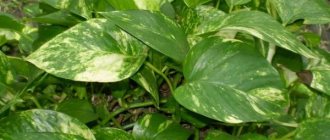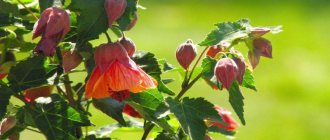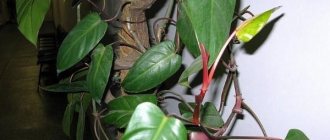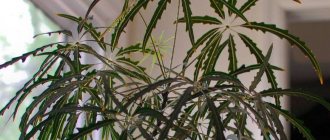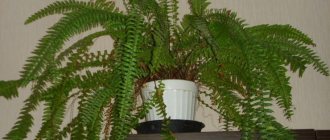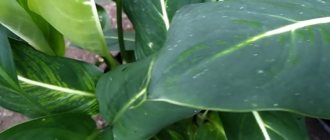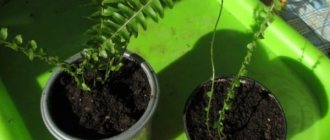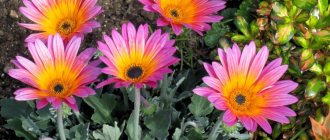A bright and attractive Dieffenbachia with luxurious striped leaves native to South America. The genus is named after the Austrian botanist Joseph Dieffenbach, who was head gardener at the Imperial Botanical Garden in Vienna in the 19th century.
All types of Dieffenbachia are evergreen plants from the Araceae family. In nature, they can grow up to 2 m, and can grow to the same size in an apartment. So you need a lot of space for this flower. The leaves are large, with spots and streaks, which gives them a special chic. But despite its beauty, Dieffenbachia can rarely be found in our apartments, because almost mystical powers are attributed to this plant. The chairman of the Moscow Flower Growers club, a collector of ornamental flowering plants, Tatyana Zhashkova, told us about the features of this plant
Types and varieties of Dieffenbachia
There are more than 60 species of Dieffenbachia in nature(1). But only a few of them are grown indoors.
Dieffenbachia seguine. In floriculture, it is better known under the old name Dieffenbachia maculata. This is one of the most popular species and the tallest - the plants reach a height of 2 m. The leaves are large, up to 50 cm long, with patterns of light specks.
There are many interesting varieties of this species.
- Green Magic - with deep green leaves with a cream vein in the center;
- Camille - it has white leaves with a green stripe along the edge;
- Compacta is a low-growing variety 50–65 cm high with light green leaves and dark green spots;
- Reflektor is a very bright variety with camouflage colored leaves: yellow and white spots are densely “scattered” on a dark green background;
- Rudolph Roehrs - with pistachio-colored leaves, a dark green stripe along the edge and a central vein of the same color, with white and green spots;
- Tropic Marianne - with cream-light green leaves with white veins and a thin dark green border;
- Tropic Sun - with light green leaves with a dark green border and central vein;
- Tropic Snow - with dark green leaves and numerous light stripes, streaks and spots;
- Tropical Tiki - with silvery leaves, on which numerous white spots are scattered, the border is dark green, and the central vein is light green.
Green Magic. Photo: YouTube
Camilla. Photo: YouTube
Reflector. Photo: YouTube
Tropical Tiki. Photo: YouTube
leopoldii . This species is native to Costa Rica. The plant is short, the trunk does not exceed 5 cm in height, but the leaves are long - up to 35 cm. They are dark green, with a white central vein. The petioles are short, about 15 cm, pale green with purple splashes.
Dieffenbachia oerstedii. Tall species up to 1.8 m high. Leaves up to 35 cm long, glossy, dark green, with a white vein in the center and sparse spots along it.
macrophylla . The species is native to Peru. The stem is up to 1 m high, the leaves are large, up to 60 cm long, rich green in color and have lighter veins. The juice has an unpleasant specific smell.
Dieffenbachia bausei. The plant is up to 90 cm high. The leaves are medium-sized, up to 30 cm long, oval, light green in color with a white marble pattern.
Dieffenbachia Estreda. Photo: YouTube
Dieffenbachia Bauze. Photo: YouTube
Lovely
The leaves of Dieffenbachia charming, compared to many other species, are elongated in length and have a less pronounced rounded shape. The light pattern along the lateral veins on the leaf plate resembles a herringbone. The contrast of the background and dark green edges makes the plant very attractive. Good lighting makes the pattern even brighter and more noticeable. If elongated spots, white stripes, and strokes occupy most of the sheet, this species is called “Tropical Snow.”
Caring for Dieffenbachia at home
Dieffenbachia is quickly becoming a favorite because it looks very impressive and is also extremely unpretentious. But some features of agricultural technology still need to be taken into account.
Priming
Dieffenbachias come from tropical forests, and there is a lot of organic matter in the soils there. Therefore, the soil for them must be fertile. Purchased soil is suitable for decorative foliage plants.
But it’s better to cook it yourself. The best option is a mixture of leaf soil, humus, peat and sand in a ratio of 3:1:1:1 (2).
Temperature
These plants do not have a pronounced dormant period, so they need to be grown in a warm place throughout the year. The optimal temperature is 20 – 25 °C; in winter it should not fall below 17 °C. Dieffenbachia does not tolerate drafts and temperature changes.
Lighting
Dieffenbachias do not tolerate bright sun, much less direct sunlight - they need shade. Moreover, they can easily be tolerated even with minimal lighting - they can be grown in the back of the room. However, in winter it is useful to place it on the windowsill (3) - at this time the sun is inactive and harmless, and away from the window it becomes too dark.
Humidity
The plant loves abundant watering (in spring and summer once every 2-3 days, in autumn and winter - once every 4-5 days), but does not tolerate excess moisture, so the pot definitely needs drainage.
Fertilizers and fertilizers
It is useful to feed Dieffenbachia once every 2 weeks from March to September - this is when they actively grow. It is best to use a complex liquid fertilizer. But it is important that it does not contain a lot of nitrogen (2) - it causes plants to grow very quickly.
Trimming
As Dieffenbachia grows, it often sheds its lower leaves, exposing the trunk - this is their natural feature. However, the plants lose their decorative properties. In order for the bushes to be lush, they need to cut off the tops once a year - then the dormant buds on the stems will wake up and new young shoots will appear.
How to feed
– we usually fertilize during the active growth phase and after the dormant phase. This is spring until the very end of summer. We use liquid mineral fertilizers that can be diluted in water for irrigation. In the summer we feed twice a week. But during the rest period - once a month. Use organic liquid fertilizers that contain nitrogen.
Dieffenbachia reproduces very well. When propagating, you can use stem or apical cuttings. In principle, the plant is resistant to pests, but if a number of growing conditions are violated, minor problems may arise. Due to violation of the watering regime, all kinds of rot of roots and stems can occur. Viral and fungal diseases. Pests include scale insects, mealybugs, spider mites, aphids and thrips. As a problem arises, we carry out preventive measures; if a disease or pest is detected, we use the appropriate medications.
When composing compositions from Dieffenbachia, we take into account its size and growth characteristics. Tall and large plants can be planted in groups in one pot, and used as a single plant. More compact forms can be planted at the foot of adult Dieffenbachias. Or place it next to the main plant. They can also be combined with decorative foliage and flowering indoor plants. It is worth paying attention to Dieffenbachia sublim, Dieffenbachia mix, Dieffenbachia mix, Dieffenbachia reflector, Dieffenbachia bush. Good luck to you.
Reproduction of Dieffenbachia at home
Photo: YouTube
Dieffenbachias reproduce well vegetatively and there are 2 methods that give excellent results.
Apical cuttings. In this case, cut off the top of the plant, tear off the lower leaves, if any, and plant the cuttings in a mixture of sand and sphagnum moss in equal proportions (2).
Stem pieces. It is better to root them in a mixture of sand and soil, also in equal proportions (2). Each piece should have 2–3 internodes. The stem sections are laid horizontally on the ground and covered with film or glass.
Both propagation options give best results in summer and late December. Cutting cuttings and pieces of stems is best combined with pruning the plant.
Reproduction
Every owner of such a beautiful plant as Dieffenbachia should know how to propagate it, so that when the bush grows, it can be renewed or simply get a couple more young plants. There are several effective methods of reproduction, which we will discuss in more detail.
Apical cuttings
Instructions for propagation by apical cuttings are as follows:
- Prepare cuttings 15 cm long by cutting them from the top of the bush.
- Perform rooting by placing the cuttings in a glass of water or planting them in a special substrate. To prepare the soil, mix peat and sand in equal proportions.
- Add an activated carbon tablet to the water to disinfect the plant. After the roots have formed (3-4 cm in length), plant them in the ground.
- If the seedlings take root in the ground, then create a “greenhouse” for them by covering the container with film.
Stem cuttings
This method is also simple:
- Cut the Dieffenbachia trunk into cuttings 10-15 cm long.
- Treat the sections with activated carbon and dry for 24 hours.
- Place the planting material on the soil and sprinkle with soil so that half of the plant remains on the surface.
Expert opinion
Vera Ivanovna Sh
Since childhood, I have been interested in growing indoor flowers, then I decided to devote my life to landscape design and gardening.
Propagation by stem cuttings takes a long time, because... the plant takes root very slowly, sometimes over the course of a year.
Leaves
Large leaves without any signs of disease are suitable for propagation, but in no case old ones. The procedure is as follows:
- Select healthy leaves and cut them from the bush;
- Dry the leaves and then place them in a container with water;
- After the roots appear (about 2 cm), plant them in the soil;
- Cover the seedlings with polyethylene. Further care should be carried out according to general rules.
The leaves can be planted directly into the soil, but this method may cause the roots to rot.
Dividing the root
Typically, this method is used when replanting a plant. The instructions are:
- Water the flower generously and carefully remove it from the pot so as not to damage the earthen lump;
- Rinse the roots with running water and carefully unravel them;
- Inspect the root system for the presence of gray rot and, if detected, remove infected areas;
- Dry the plants for 24 hours, then plant them in new soil.
To disinfect the roots, use crushed activated carbon or a weak solution of potassium permanganate.
Dieffenbachia diseases
Photo: YouTube
Problems with Dieffenbachia usually occur due to improper care.
The stem rots. This often happens if the plant is overwatered or the room is cool - the temperature is below 17 °C.
At the initial stage, when only part of the shoot is affected, the diseased tissue can be cut out with a sharp knife and the wound can be sprinkled with crushed charcoal. If the stem is severely rotten, you need to cut off and root the healthy top, and throw away the rest.
Leaves become pale. This happens if the plant is in too bright a room or if direct sunlight falls on it.
Move the Dieffenbachia to a darker place and the color of the leaves will soon be restored.
Young leaves fall. There are three reasons for this problem:
- temperature too low;
- dry air;
- drafts.
Move Dieffenbachia to a warm place and spray more often.
The edges of the leaves dry out. This occurs due to lack of watering - Dieffenbachias do not like it when the soil dries out; it should always be moist. The second possible reason is cold air.
Lighting
Dieffenbachia, unlike most indoor plants, feels comfortable not in well-lit places, but in shaded ones, protected from direct sunlight. When growing this flower in full shade, the plant may slow down its development, and direct rays of the sun (especially during the daytime) will leave burns on the leaves. Dieffenbachia must be accustomed to changing lighting conditions gradually. In this case, there will be no problems either with the shady location of the flower or when grown in diffuse sunlight.
It is necessary to regularly rotate pots with plants around their own axis so that they develop symmetrically and do not stretch towards the light source.
Pests of Dieffenbachia
Dieffenbachia most often affects 2 types of pests.
Spider mite. The first signs are numerous small whitish dots on the leaves. With severe infection, the leaves begin to turn yellow and fall off, and cobwebs appear on the plant.
To destroy spider mites, you can use the drug Kleschevit (4).
Shield. It usually lives on stems and on the undersides of leaves. The insects are motionless and look like small brown tubercles. With severe damage, the growth of Dieffenbachia slows down greatly, its leaves begin to dry out and eventually the plant may die.
It is difficult to fight scale insects. The first step is to manually remove all insects using a cotton pad soaked in alcohol or vodka. And then carry out 2 - 3 treatments of the plant with Actellik (4).
Why can't Dieffenbachia be kept at home?
The juice of this plant is poisonous to people and animals. If it gets on the skin, it can cause serious burns. If the juice gets into the stomach, swelling of the larynx and tongue, blurred vision, interruptions in heart function, and anaphylactic shock may occur. Therefore, it is not recommended to keep diffebanchias in apartments where there are animals and small children.
In addition to the obvious harm from the poisonous juice, the reputation of Dieffenbachia is also spoiled by the superstitions associated with it. It is believed that in ancient times, the leaf of this plant could deprive a person of speech by sealing his mouth (which is completely understandable - the poisonous juice, causing swelling of the larynx and tongue, did not give the person the opportunity to speak).
But now there is a different opinion: Dieffenbachia is called “husband,” a symbol of celibacy. It is believed that this plant weakens male energy, which is why men cannot be in the same room with it. Therefore, it is not recommended for unmarried girls to have it. By weakening male energy, Dieffenbachia allegedly makes married couples infertile.
But, of course, this is nothing more than superstition.
Disadvantages of the plant
Before placing Dieffenbachia in your home, you must carefully read the description of the flower. There are pitfalls that are important to know about in advance. Firstly, Dieffenbachia has dangerous juice.
If there are small children or pets in the house, then it is better to refuse it. You can accidentally break off or bite off a leaf or part of the trunk. This is fraught not only with burns, but also with poisoning. Depending on the scale of the disaster, the consequences can be not only sad, but also tragic.
In addition, according to legend, the flower weakens male energy and strength. This can lead to a decrease in the activity of representatives of the stronger half, even infertility of married couples.
Popular questions and answers
Agronomist-breeder Svetlana Mikhailova told us about growing Dieffenbachia and the problems that may arise
How to choose Dieffenbachia?
Always pay attention to the appearance of the plant - there should be no stains, mechanical damage or signs of pests on the leaves. Inspect the shoots - it is important that they are not rotten.
Does Dieffenbachia bloom?
Yes, it blooms, but at home this does not happen often. And the flowers of Dieffenbachia are inconspicuous - a small cob surrounded by a green blanket.
Why do Dieffenbachia leaves turn yellow?
If the old lower leaves turn yellow and fall off, this is normal; this is a natural feature of Dieffenbachia. However, if young leaves turn yellow, then most likely the room is cool or the plant is in a draft.
Diffembachia: a dangerous plant (video)
Many amateur gardeners prefer Dieffenbachia due to the fact that they highly value the beneficial properties of this decorative indoor crop. The benefits of the plant are due to its chemical composition, which helps improve the indoor microclimate and alleviates the condition of people suffering from allergies or diseases of the respiratory system. It is important to note that with age, Dieffenbachia acquires a palm-like appearance, which not all gardeners like, but is a characteristic feature of almost all types of this ornamental plant.
Sources
- Dieffenbachia // The Plant List (https://www.theplantlist.org/1.1/browse/A/Araceae/Dieffenbachia/)
- Visyashcheva L.V., Sokolova T.A. Industrial floriculture. Textbook for technical schools // M.: Agropromizdat, 1991 – 368 p.
- Dr. Hessayon D.G. All about indoor plants // M.: Kladez-Buks, 2002 – 256 p.
- State catalog of pesticides and agrochemicals approved for use on the territory of the Russian Federation as of July 6, 2022 // Ministry of Agriculture of the Russian Federation (https://mcx.gov.ru/ministry/departments/departament-rastenievodstva-mekhanizatsii-khimizatsii -i-zashchity-rasteniy/industry-information/info-gosudarstvennaya-usluga-po-gosudarstvennoy-registratsii-pestitsidov-i-agrokhimikatov/)
Dieffenbachia - harm or benefit?
If, when working with a plant, its juice gets on the skin or mucous membranes, this will lead to redness, swelling, a burning sensation and temporary numbness, as from local anesthesia. If Dieffenbachia juice is swallowed, it will most likely lead to vomiting, excessive salivation, and paralysis of the vocal cords. In this regard, you should choose a place for the plant that is difficult to reach for small children. If, however, the juice was swallowed, then you should thoroughly rinse your mouth with clean water as soon as possible, and then drink activated charcoal. It is also recommended to consult a doctor.
Where Dieffenbachia comes from, it is considered a common weed. It is destroyed there, and people try to carefully ensure that its remains do not end up in livestock feed. This plant was previously used to make poison for insects and rodents. It was also used to punish slaves by making rods out of the stems. After such an execution, the slave suffered for 7 whole days. It should be taken into account that the juice of wild Dieffenbachia contains more toxic substances than its domestic sister.
But despite this, Dieffenbachia is also considered a useful plant. According to NASA, this plant, along with dracaenas and ficuses, helps clean the air from toxic substances: trichloroethane, benzene, formaldehyde and xylene. In this regard, the kitchen is ideal for growing Dieffenbachia.
DIFFENBACHIA CARE AT HOME Dieffenbachia
